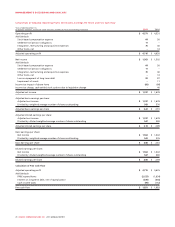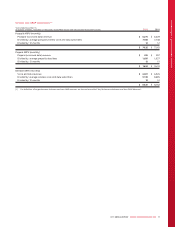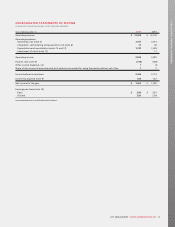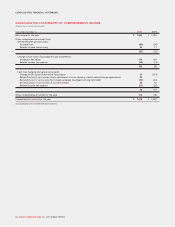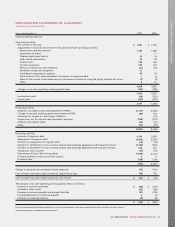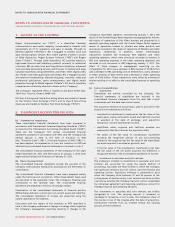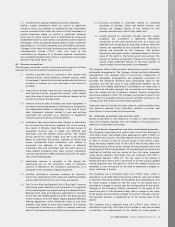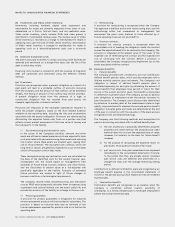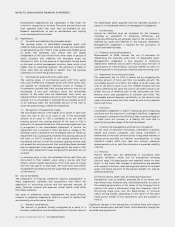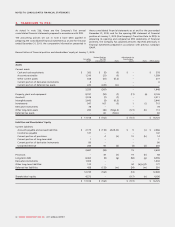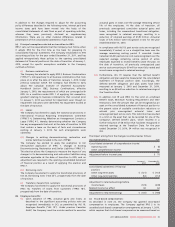Rogers 2011 Annual Report Download - page 89
Download and view the complete annual report
Please find page 89 of the 2011 Rogers annual report below. You can navigate through the pages in the report by either clicking on the pages listed below, or by using the keyword search tool below to find specific information within the annual report.
NOTES TO CONSOLIDATED FINANCIAL STATEMENTS
(iii) Investments in publicly traded and private companies:
Publicly traded investments where no control or significant
influence exists are classified as available-for-sale investments
and are recorded at fair value. Fair value of other investments in
private companies where no control or significant influence
exists and no active market exists is determined by using well
established market or asset based, or projected income valuation
techniques, which are applied appropriately to each investment
depending on its future operating and profitability prospects.
Changes in fair value of these investments are recorded in other
comprehensive income (“OCI”) until such time as the
investments are disposed of or become impaired. Investments
are considered impaired when there is a significant or prolonged
decline in fair value below cost.
(d) Revenue recognition:
The Company’s principal sources of revenues and recognition of these
revenues for financial statement purposes are as follows:
(i) monthly subscriber fees in connection with wireless and
wireline services, cable, telephony, Internet services, rental
of equipment, network services and media subscriptions are
recorded as revenue on a pro rata basis as the service is
provided;
(ii) revenue from airtime, data services, roaming, long-distance
and optional services, pay-per-use services, video rentals
and other sales of products are recorded as revenue as the
services or products are delivered;
(iii) revenue from the sale of wireless and cable equipment is
recorded when the equipment is delivered and accepted by
the independent dealer or subscriber in the case of direct
sales. Equipment subsidies related to new and existing
subscribers are recorded as a reduction of equipment
revenues upon activation of the equipment;
(iv) installation fees and activation fees charged to subscribers
do not meet the criteria as a separate unit of accounting.
As a result, in Wireless, these fees are recorded as part of
equipment revenue and, in Cable, are deferred and
amortized over the related service period. The related
service period for Cable ranges from 26 to 48 months,
based on subscriber disconnects, transfers of service and
moves. Incremental direct installation costs related to
reconnects are deferred to the extent of deferred
installation fees and amortized over the same period as
these related installation fees. New connect installation
costs are capitalized to PP&E and amortized over the useful
lives of the related assets;
(v) advertising revenue is recorded in the period the
advertising airs on the Company’s radio or television
stations; is featured in the Company’s publications; or is
displayed on the Company’s digital properties;
(vi) monthly subscription revenues received by television
stations for subscriptions from cable and satellite providers
are recorded in the month in which they are earned;
(vii) The Toronto Blue Jays Baseball Club’s (“Blue Jays”) revenue
from home game admission and concessions is recognized
as the related games are played during the baseball season.
Revenue from radio and television agreements is recorded
at the time the related games are aired. The Blue Jays also
receive revenue from the Major League Baseball Revenue
Sharing Agreement, which distributes funds to and from
member clubs, based on each club’s revenues. This revenue
is recognized in the season in which it is earned, when the
amount is estimable and collectibility is reasonably assured;
(viii) discounts provided to customers related to combined
purchases of Wireless, Cable and Media products and
services are charged directly to the revenue for the
products and services to which they relate; and
(ix) awards granted to customers through customer loyalty
programs are considered a separately identifiable
component of the sales transactions and, as a result, are
deferred until recognized as operating revenue when the
awards are redeemed by the customer and the goods or
services are provided by the Company. The portion
allocated to the award credit is estimated based on the fair
value of the right to the future goods and services. The
amount of revenue recognized is based on the number of
award credits redeemed relative to the total number of
award credits that are expected to be redeemed.
The Company offers certain products and services as part of multiple
deliverable arrangements. The Company divides multiple deliverable
arrangements into separate units of accounting. Components of
multiple deliverable arrangements are separately accounted for
provided the delivered elements have stand-alone value to the
customers and the fair value of any undelivered elements can be
objectively and reliably determined. Consideration for these units is
measured and allocated amongst the accounting units based upon
their fair values and the Company’s relevant revenue recognition
policies are applied to them. The Company recognizes revenue to the
extent that it is probable that the economic benefits will flow to the
Company and the revenue can be reliably measured.
Unearned revenue includes subscriber deposits, cable installation fees
and amounts received from subscribers related to services and
subscriptions to be provided in future periods.
(e) Subscriber acquisition and retention costs:
Except as described in note 2(d)(iv) as it relates to cable installation
costs, the Company expenses the costs related to the acquisition or
retention of subscribers as incurred.
(f) Stock-based compensation and other stock-based payments:
The Company’s employee stock option plans, which are described in
note 22(a), attach cash-settled share appreciation rights (“SARs”) to
all granted stock options. The SARs feature allows the option holder
to elect to receive in cash an amount equal to the intrinsic value,
being the excess market price of the Class B Non-Voting share over
the exercise price of the option, instead of exercising the option and
acquiring Class B Non-Voting shares. All outstanding stock options are
classified as liabilities and are carried at their fair value, measured
using option valuation techniques that are compliant with IFRS 2,
Share-based Payment (“IFRS 2”). The fair value of the liability is
remeasured each period and is amortized to income using a graded
vesting approach over the period in which the related services are
rendered, or over the period to the date an employee is eligible to
retire, whichever is shorter.
The Company has a restricted share unit (“RSU”) plan, which is
described in note 22(b). RSUs that will be settled in cash are recorded
as liabilities. The measurement of the liability and compensation costs
for these awards is based on the fair value of the award and is
recorded as a charge to income over the vesting period of the award.
Changes in the Company’s liability subsequent to the grant of the
award and prior to the settlement date, due to changes in fair value
of the award, are recorded as a charge to income in the year incurred.
The payment amount is established as of the vesting date of the
award.
The Company has a deferred share unit (“DSU”) plan, which is
described in note 22(c). DSUs that will be settled in cash are recorded
as liabilities. The measurement of the liability for these awards is
2011 ANNUAL REPORT ROGERS COMMUNICATIONS INC. 85



